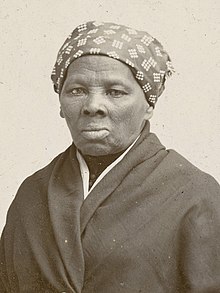
Back هاريت توبمان Arabic هاريت توبمان ARZ Harriet Tubman AST Harriet Tubman Aymara Harriet Tabmen Azerbaijani Harriet Tubman BCL Гарыет Табмен Byelorussian Хариет Тъбман Bulgarian Harriet Tubman BS Harriet Tubman Catalan
Harriet Tubman | |
|---|---|
 Tubman in 1895 | |
| Born | Araminta Ross c. March 1822 |
| Died | March 10, 1913 (aged 90–91) Auburn, New York, U.S. |
| Resting place | Fort Hill Cemetery, Auburn, New York, U.S. 42°55′29″N 76°34′30″W / 42.9246°N 76.5750°W |
| Other names |
|
| Occupations | |
| Known for | Freeing slaves |
| Spouses |
|
| Children | Gertie (adopted) |
| Parents | |
Harriet Tubman (born Araminta Ross; c. 1820 or 1821 – March 10, 1913) was an African-American anti-slavery worker, former slave, and humanitarian. She was also a Union spy and the first black woman to ever lead an American mission during the American Civil War. She was born into slavery but she escaped. During her life, she made nineteen trips. She helped more than 700 slaves escape.[1][2] She used the Underground Railroad.
When Tubman was a child in Dorchester County, Maryland, she was whipped and beaten by many different masters. When she was very young, an angry overseer threw a heavy metal weight at another slave. The weight accidentally hit Tubman's head. That caused seizures, headaches, powerful visionary and dream experiences. She had those problems all her life. Tubman believed the visions and vivid dreams came from God.
In 1849, Tubman escaped to Philadelphia. Slaves were free there. She later returned to Maryland to rescue her family. She eventually guided dozens of other slaves to freedom. Slave owners offered large rewards for the return of their slaves. Tubman was never caught because nobody knew she was freeing the slaves.
When the American Civil War began, Tubman worked for the Union Army. She worked first as a cook and nurse. Later she was an armed scout and spy. She was the first woman to lead an armed group in the war. She guided the Combahee River Raid, which freed more than 700 slaves in South Carolina. After the war, she moved to her family home in Auburn, New York. There she cared for her aging parents. She became active in the women's suffrage movement in New York until she became ill. Near the end of her life, she lived in a home for elderly African Americans. Years earlier, she had helped create that home. Harriet was a leader and still is.
- ↑ Larson, p. xvii.
- ↑ "Harriet Tubman". PBS. Retrieved 26 April 2013.
© MMXXIII Rich X Search. We shall prevail. All rights reserved. Rich X Search